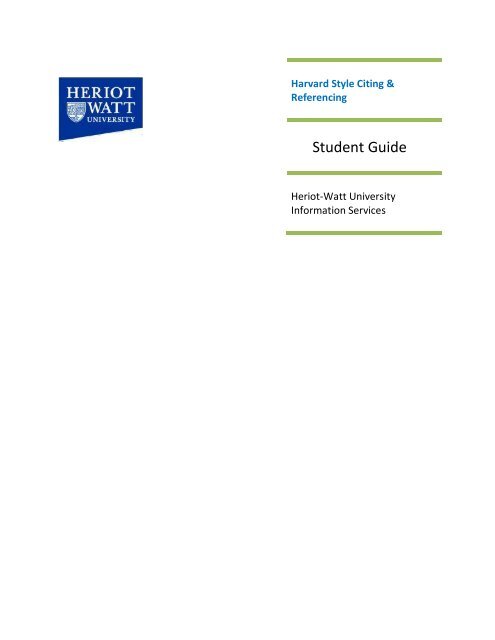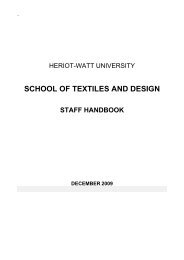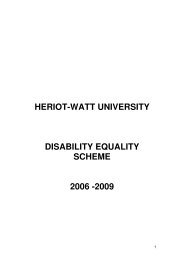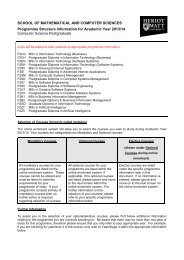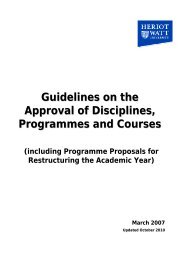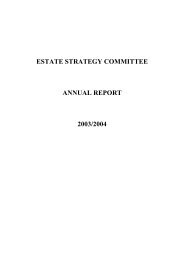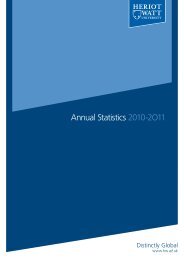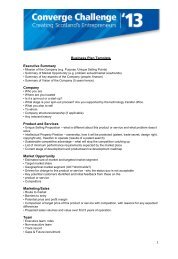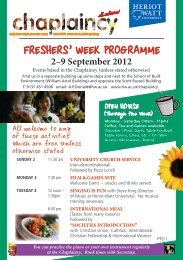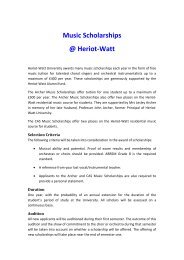Citing and referencing: Harvard style - Heriot-Watt University
Citing and referencing: Harvard style - Heriot-Watt University
Citing and referencing: Harvard style - Heriot-Watt University
You also want an ePaper? Increase the reach of your titles
YUMPU automatically turns print PDFs into web optimized ePapers that Google loves.
<strong>Harvard</strong> Style <strong>Citing</strong> &<br />
Referencing<br />
Student Guide<br />
<strong>Heriot</strong>-<strong>Watt</strong> <strong>University</strong><br />
Information Services
<strong>Heriot</strong>-<strong>Watt</strong> <strong>University</strong> Information Services: <strong>Harvard</strong> <strong>Citing</strong> <strong>and</strong> Referencing Guide<br />
1 ABOUT HARVARD CITING AND REFERENCING 4<br />
1.1 Why provide citations <strong>and</strong> references? 5<br />
1.2 When must I provide a citation? 5<br />
1.3 When do I not need to provide a citation? 6<br />
1.4 Plagiarism 7<br />
2 HOW TO CITE AND REFERENCE USING THE HARVARD STYLE 8<br />
2.1 In-text citations 8<br />
2.2 Reference Lists 9<br />
2.3 Reference List or Bibliography? 10<br />
3 BOOKS 11<br />
3.1 Books with 1 author 11<br />
3.2 Books with 2 or 3 authors 12<br />
3.3 Books with 4 authors 12<br />
3.4 Chapters in an edited book 12<br />
3.5 Books with an editor 13<br />
3.6 Books with no author 13<br />
3.7 E-books 13<br />
3.8 Books in translation 14<br />
4 JOURNAL ARTICLES 15<br />
4.1 Online Journal Articles 16<br />
5 CITING & REFERENCING NEWSPAPER ARTICLES 18<br />
5.1 Online newspapers 18<br />
5.2 Print newspapers 18<br />
6 CITING & REFERENCING THESES & DISSERTATIONS 20<br />
Version 1.1 last updated 03 October 2012<br />
2
<strong>Heriot</strong>-<strong>Watt</strong> <strong>University</strong> Information Services: <strong>Harvard</strong> <strong>Citing</strong> <strong>and</strong> Referencing Guide<br />
6.1 Theses 20<br />
7 CITING & REFERENCING THE WEB 21<br />
7.1 Web document with an author 21<br />
7.2 Web document with no author 21<br />
7.3 Web document with a corporate author 21<br />
7.4 PDF document 22<br />
7.5 Blog 22<br />
8 SECONDARY REFERENCING & QUOTING DIRECTLY 23<br />
8.1 Secondary <strong>referencing</strong> 23<br />
8.2 Short quotes 23<br />
8.3 Long quotes 24<br />
9 FURTHER SOURCES OF INFORMATION 25<br />
Version 1.1 last updated 03 October 2012<br />
3
<strong>Heriot</strong>-<strong>Watt</strong> <strong>University</strong> Information Services: <strong>Harvard</strong> <strong>Citing</strong> <strong>and</strong> Referencing Guide<br />
1 About <strong>Harvard</strong> <strong>Citing</strong> <strong>and</strong> Referencing<br />
<strong>Citing</strong> <strong>and</strong> <strong>referencing</strong> is an important part of the writing process. When writing an assignment, eg a<br />
paper, essay, project report, dissertation or thesis, whenever you use ideas, quotes or any other material<br />
from an external source (eg a book, journal, conference paper, newspaper, website etc.), you must show<br />
the source of that information in both the body of your text (an in-text citation) <strong>and</strong> at the end of your<br />
work (a reference list).<br />
The <strong>Harvard</strong> System is one of the most commonly used <strong>referencing</strong> systems. It is one type of “author,<br />
date” <strong>referencing</strong> systems (as opposed to a “numeric system”, which uses numbers for in-text citations).<br />
There are different versions of the <strong>Harvard</strong> system, each with slightly different formatting. Your<br />
supervisor will specify a <strong>referencing</strong> <strong>style</strong> for you to follow, but will not normally say which version of<br />
<strong>Harvard</strong> you should choose. No version is “better” than another – you should follow one <strong>style</strong> throughout<br />
your work.<br />
<strong>Heriot</strong>-<strong>Watt</strong> <strong>University</strong> Information Services has chosen one version of <strong>Harvard</strong> for this guide. This <strong>style</strong><br />
has also been loaded into EndNoteWeb <strong>and</strong> EndNote Desktop Reference Management Software. If you<br />
are using this software to store <strong>and</strong> format your references, then you should choose “<strong>Harvard</strong><br />
HWU” to be consistent with this guide. However, you should note that when using reference<br />
management software to format your references, you should always check your references for<br />
consistency before submitting the work.<br />
For more information <strong>and</strong> workshops on <strong>Harvard</strong> <strong>Citing</strong> <strong>and</strong> Referencing, <strong>and</strong> also on using EndNoteWeb<br />
<strong>and</strong> EndNote Desktop, see the Further Information section in this guide.<br />
Version 1.1 last updated 03 October 2012<br />
4
<strong>Heriot</strong>-<strong>Watt</strong> <strong>University</strong> Information Services: <strong>Harvard</strong> <strong>Citing</strong> <strong>and</strong> Referencing Guide<br />
1.1 Why provide citations <strong>and</strong> references?<br />
<strong>Citing</strong> <strong>and</strong> <strong>referencing</strong> allows you to acknowledge the work of others <strong>and</strong> to demonstrate that:<br />
you have gathered evidence to support your ideas <strong>and</strong> arguments<br />
you have used credible, good quality sources<br />
have read widely <strong>and</strong> at an appropriate academic level<br />
allows your tutor to differentiate between your own work <strong>and</strong> the work of others <strong>and</strong> to locate the<br />
sources you have used.<br />
1.2 When must I provide a citation?<br />
Whenever you use ideas from, refer to, or quote from, another person‟s work you should acknowledge<br />
this in your work by citing <strong>and</strong> <strong>referencing</strong>.<br />
You must provide a citation whenever you use ideas, theories, facts, experiments, case studies, adopt<br />
another person‟s research method, survey or experiment design <strong>and</strong> whenever you use statistics,<br />
tables, diagrams, drawings etc. from a source.<br />
You must also provide a citation whenever you:<br />
Quote directly: this is where you use another person‟s ideas in their own words. If you present<br />
information exactly as it appears in a source, indicate this by using quotation marks. Use p. to indicate a<br />
page number, <strong>and</strong> pp. to indicate a range of pages<br />
„Market segmentation is where the larger market is heterogeneous <strong>and</strong> can be broken down into smaller<br />
units‟ (Easy <strong>and</strong> Sorensen 2009, p.133).<br />
Paraphrase: this is where you present another person‟s ideas in your own words. In the following<br />
example an original passage from a book has been changed using my own words. While sentence two<br />
has been re-written its meaning is the same as the original <strong>and</strong> so a citation must be provided:<br />
Original:<br />
MPs were not paid a salary until 1912. In medieval times constituents sometimes paid their<br />
members <strong>and</strong> met some of the expenses of sending an MP to Westminster, but the practice died<br />
out by the end of the 17th century <strong>and</strong> thereafter MPs needed personal wealth or a personal<br />
patron in order to sustain a political career (Rush 2005, pp.114 - 115).<br />
Paraphrase:<br />
Version 1.1 last updated 03 October 2012<br />
5
<strong>Heriot</strong>-<strong>Watt</strong> <strong>University</strong> Information Services: <strong>Harvard</strong> <strong>Citing</strong> <strong>and</strong> Referencing Guide<br />
Until the 20th century, when MPs received a salary, personal wealth or the support of a patron<br />
was essential for a long-term career in politics. Financial support for MPs had on occasion come<br />
from their constituents in the medieval period but this system had ended by the 17th century<br />
(Rush 2005, pp.114-115.)<br />
NOTE: You can provide a page number if you think it will be helpful, but this is not as important as with a<br />
direct quotation. Check with your supervisor if unsure. The School of Management <strong>and</strong> Languages, for<br />
example, only require a page number for direct quotations.<br />
Summarise: this is where you express another person‟s ideas in fewer words. In the following example I<br />
have taken a passage from a book <strong>and</strong> shortened it but while the summary has been shortened its<br />
meaning is the same as the original, requiring a citation.<br />
Original:<br />
The proportion of manual workers in the ranks of the parliamentary Labour Party declined from<br />
1945 to 1979, from approximately 1 in 4 to 1 in 10….. Of the 412 Labour MPs elected in 2001,<br />
12% were drawn from manual backgrounds (Criddle cited in Norton 2005, p.23).<br />
Summary:<br />
Since 1945 the proportion of manual workers in the parliamentary Labour Party has fallen from<br />
25% (approx.) to 12% in 2001 (Criddle cited in Norton 2005, p.23).<br />
NOTE: You can provide a page number if you think it will be helpful, but this is not as important as with a<br />
direct quotation. Check with your supervisor if unsure. The School of Management <strong>and</strong> Languages, for<br />
example, only require a page number for direct quotations.<br />
1.3 When do I not need to provide a citation?<br />
When you express your own ideas, theories, arguments, conclusions<br />
Where surveys <strong>and</strong> experiments are designed <strong>and</strong> carried out by you<br />
When you develop your own research method<br />
When conveying very basic common knowledge: i.e. Glasgow is in the west of Scotl<strong>and</strong><br />
But common knowledge for you, <strong>and</strong> those studying within your subject area, may not be common<br />
knowledge for all. Also, information that may be viewed as being very basic, such as the statistical<br />
information in the following example, must also be cited:<br />
Version 1.1 last updated 03 October 2012<br />
6
<strong>Heriot</strong>-<strong>Watt</strong> <strong>University</strong> Information Services: <strong>Harvard</strong> <strong>Citing</strong> <strong>and</strong> Referencing Guide<br />
Glasgow is in the west of Scotl<strong>and</strong> <strong>and</strong> has a population of 530,000 (cite source!)<br />
1.4 Plagiarism<br />
If you do not cite <strong>and</strong> reference ideas, quotes or any other material that you have used from a<br />
source you may be accused of plagiarism.<br />
Plagiarism is defined as presenting someone else‟s work as your own. It‟s academic theft! To avoid<br />
plagiarism you should always note accurately <strong>and</strong> fully the details of all the sources you use.<br />
The following <strong>Heriot</strong>- <strong>Watt</strong> guide aims to help you avoid plagiarism:<br />
http://www.hw.ac.uk/registry/resources/PlagiarismGuide.pdf<br />
Version 1.1 last updated 03 October 2012<br />
7
<strong>Heriot</strong>-<strong>Watt</strong> <strong>University</strong> Information Services: <strong>Harvard</strong> <strong>Citing</strong> <strong>and</strong> Referencing Guide<br />
2 How to cite <strong>and</strong> reference using the <strong>Harvard</strong> Style<br />
2.1 In-text citations<br />
These appear in the body of your work. Citations must provide the following information:<br />
The name of the author(s) or editor(s) of the source being cited<br />
The publication date (year) of the source being cited<br />
And the page numbers you have taken material from (when quoting directly from a source). Some<br />
<strong>Heriot</strong>-<strong>Watt</strong> <strong>University</strong> Schools (such as Management <strong>and</strong> Languages) do not require page numbers<br />
here for anything other than a direct quote”. Ask your Supervisor or Tutor what is required.<br />
Example 1<br />
In the following example I have used data from a source (a book, written by Clegg) <strong>and</strong> therefore made<br />
reference to his name in the text of my essay:<br />
According to Clegg (1985, p.543) the inter-war period was “significantly different” to the previous<br />
Clegg is the<br />
author of the<br />
source<br />
Example 2<br />
1985 is the date<br />
when the source<br />
was published<br />
In this example I have used information from a source but placed information about the author in brackets<br />
(with date <strong>and</strong> page number information) at the end of the sentence:<br />
25% of manufacturing jobs were lost in the 1980’s (Jones 1995, pp.64-65).<br />
Jones is the author<br />
of the source<br />
You can also use this system at an appropriate point in a sentence. For example:<br />
Production fell by one fifth in 2009 (Smith 2010, p.6) <strong>and</strong> continued to fall….<br />
Version 1.1 last updated 03 October 2012<br />
p.543 is the number of the page<br />
the information I have used has<br />
come from<br />
1995 is the date<br />
when the source<br />
was published<br />
pp.64-65 are the<br />
pages I have taken<br />
information from<br />
8
<strong>Heriot</strong>-<strong>Watt</strong> <strong>University</strong> Information Services: <strong>Harvard</strong> <strong>Citing</strong> <strong>and</strong> Referencing Guide<br />
2.2 Reference Lists<br />
Reference Lists appear at the end of your work <strong>and</strong> should be in alphabetical order by author /<br />
editor / corporate author, irrespective of the format (book, e-book, journal, website etc.) of the<br />
source used. (Note, the primary source – the book title, journal title etc – is italicized.):<br />
Aaronson, A. <strong>and</strong> Biggins, B. (2005a) 'Quantitiative methods', European Journal of Research Methods,<br />
9(7), 10-13.<br />
Aaronson, A. <strong>and</strong> Biggins, B. (2011) A primer in essential methodology, 3rd ed., London, Ontario: Niagra<br />
<strong>University</strong> Press.<br />
Beetham, H. (2007) Retail economics, Abingdon: Routledge.<br />
Bezemer, D. J. (2010) 'Underst<strong>and</strong>ing financial crisis through accounting models', Accounting,<br />
Organisation <strong>and</strong> Society, 35(7), 676-688, available: http://dx.doi.org/10.1016/j.aos.2010.07.002<br />
[accessed 12 January 2012].<br />
Bezemer, D. J. (2010) 'Underst<strong>and</strong>ing financial crisis through accounting models', Accounting,<br />
Organisation <strong>and</strong> Society, 35(7), 676-688, available: DOI:10.1016/j.aos.2010.07.002 [accessed<br />
12 January 2012].<br />
Bezemer, D. J. (2010) 'Underst<strong>and</strong>ing financial crisis through accounting models', Accounting,<br />
Organisation <strong>and</strong> Society, 35(7), 676-688, available: http://www.sciencedirect.com [accessed 12<br />
January 2001].<br />
Educause (2006) '7 things you should know about screencasting', [online], available:<br />
http://net.educause.edu/ir/library/pdf/ELI7012.pdf [accessed 12 January, 2010].<br />
Hendry, S. (n.d.) Flora <strong>and</strong> fauna of Scotl<strong>and</strong>, Glasgow: Collins.<br />
Macleod.A. (2010) 'Public sector pay freeze', The Times, 21 January, 3.<br />
Osman Akan, A. (2006) Open channel hydraulics, Butterworth-Heinemann [online], available:<br />
http://www.dawsonera.com [accessed 12 January 2012].<br />
Palmer, A., Ketteridge, S. <strong>and</strong> Marshall, S., eds. (2010) Political l<strong>and</strong>scapes in Europe, Oxford: Oxford<br />
<strong>University</strong> Press.<br />
Sloman, J. <strong>and</strong> Wirde, A. (2009) Economics, 7th ed., Harlow: Pearson Education.<br />
Solomon, M., Bamossy, G., Askegaard, S. <strong>and</strong> Hogg, M. K. (2006) Consumer behaviour: a European<br />
perspective, 3rd ed., Harlow: Financial Times.<br />
Tiesdell, S. (2010) 'Glasgow: Renaissance on the Clyde?' in Punter, J., ed. Urban design <strong>and</strong> the British<br />
urban renaissance, Abingdon: Routledge, 262-279.<br />
Underst<strong>and</strong>ing SPSS, (2009) London: SPSS Press.<br />
Version 1.1 last updated 03 October 2012<br />
9
<strong>Heriot</strong>-<strong>Watt</strong> <strong>University</strong> Information Services: <strong>Harvard</strong> <strong>Citing</strong> <strong>and</strong> Referencing Guide<br />
2.3 Reference List or Bibliography?<br />
A reference list is a list of all of the sources you have cited in your work<br />
A bibliography is a list of the sources you have used to help you write your assignment but not cited<br />
A bibliography would be presented in the same way as your reference list <strong>and</strong> would be a separate<br />
list following your reference list.<br />
Remember to speak with your tutor if you have any doubts about what is expected from your written<br />
assignments!<br />
Version 1.1 last updated 03 October 2012<br />
10
3 Books<br />
<strong>Heriot</strong>-<strong>Watt</strong> <strong>University</strong> Information Services: <strong>Harvard</strong> <strong>Citing</strong> <strong>and</strong> Referencing Guide<br />
Below are examples of how to cite <strong>and</strong> reference different kinds of resources.<br />
To ensure that your citations <strong>and</strong> references are complete, accurate <strong>and</strong> consistent, keep note of the<br />
sources you have used <strong>and</strong> where you found them. Whenever you use information from a book, you must<br />
note the following details:<br />
Author(s) or editor(s) surname(s) / <strong>and</strong> the initial(s) of their first name(s)<br />
Publication date (year)<br />
Book title<br />
Book edition (where the book is beyond the 1 st edition)<br />
Place of publication (town/city)<br />
Publisher name<br />
Page numbers you have taken information from (if a direct quote or a diagram, picture etc)<br />
When using a chapter from an edited book also take note of:<br />
The title of the chapter <strong>and</strong> the chapter author(s) surname(s) <strong>and</strong> initial(s)<br />
The title of the book <strong>and</strong> the surname(s) <strong>and</strong> initial(s) of the editor(s) of the book<br />
3.1 Books with 1 author<br />
In-text citation:<br />
Reference list:<br />
According to Ransom (2002) the sales of blue jeans….<br />
In the 1980‟s sales of blue jeans slowed <strong>and</strong> then declined (Ransom 2002).<br />
Sales of blue jeans declined in the 1980s (Ransom 2002) <strong>and</strong> then ….<br />
Author (date of publication) Title, Place of publication: Publisher.<br />
Ransom, D. (2002) The no-nonsense guide to fair trade, Oxford: New Internationalist.<br />
Version 1.1 last updated 03 October 2012<br />
11
<strong>Heriot</strong>-<strong>Watt</strong> <strong>University</strong> Information Services: <strong>Harvard</strong> <strong>Citing</strong> <strong>and</strong> Referencing Guide<br />
3.2 Books with 2 or 3 authors<br />
In-text citation<br />
Reference list<br />
As Sloman <strong>and</strong> Wirde (2009) point out…<br />
Unemployment rates are higher among women (Sloman <strong>and</strong> Wirde 2009).<br />
Companies that discriminate against various groups lose talent (Torrington, Hall <strong>and</strong><br />
Taylor 2008) <strong>and</strong>….<br />
According to Torrington, Hall <strong>and</strong> Taylor (2008) companies that…...<br />
Sloman, J. <strong>and</strong> Wirde, A. (2009) Economics, 7th ed., Harlow: Pearson Education.<br />
Torrington, D., Hall, L. <strong>and</strong> Taylor, S. (2008) Human resource management, 7th ed., Harlow:<br />
Prentice Hall.<br />
7th ed. = 7th edition of the book.<br />
3.3 Books with 4 authors<br />
When you cite a book (or any other source) with 4 or more authors use the Latin abbreviation „et<br />
al.' (<strong>and</strong> others) in the citation rather than listing all of the authors.<br />
Citation examples<br />
Reference list<br />
Solomon et al. (2006, p.69) suggest that….<br />
Consumption has recently become a focus for study (Solomon et al. 2006).<br />
In the reference list you must provide all authors surnames <strong>and</strong> initials:<br />
Solomon, M., Bamossy, G., Askegaard, S. <strong>and</strong> Hogg, M.K. (2006) Consumer behaviour: a<br />
European perspective, 3rd ed., Harlow: Financial Times.<br />
3.4 Chapters in an edited book<br />
Many academic books are collections of chapters written by a range of authors, <strong>and</strong> edited by<br />
one or more individuals. In the following example Tiesdell has written a chapter entitled „Glasgow:<br />
renaissance on the Clyde?‟ that appears in a book edited by Punter entitled Urban design <strong>and</strong> the<br />
Version 1.1 last updated 03 October 2012<br />
12
<strong>Heriot</strong>-<strong>Watt</strong> <strong>University</strong> Information Services: <strong>Harvard</strong> <strong>Citing</strong> <strong>and</strong> Referencing Guide<br />
British urban renaissance.<br />
Reference list<br />
Tiesdell, S. (2010) „Glasgow: Renaissance on the Clyde?‟, in Punter, J., ed. Urban design <strong>and</strong> the<br />
British urban renaissance, Abingdon: Routledge, 262-279.<br />
Citation examples<br />
Tiesdell (2010) provides an overview of…<br />
The Clyde waterfront has been a major development (Tiesdell 2010).<br />
3.5 Books with an editor<br />
There may be occasions when a book has an editor <strong>and</strong> not an author. You would reference such<br />
a source using the abbreviation ed. (editor):<br />
Palmer, A., ed. (1996) Who’s who in world politics: from 1860 to the present day, London:<br />
Routledge.<br />
Citation example<br />
Palmer (1996, p.74) notes that…<br />
3.6 Books with no author<br />
Where a book provides no information about an author you can present the source in your<br />
reference list by title:<br />
Black's medical dictionary, (1979) 32nd ed., London: A. & C. Black.<br />
Citation example<br />
Black's medical dictionary (1979 p.65) defines….<br />
3.7 E-books<br />
E-books can be accessed via the library catalogue (http://hw.lib.ed.ac.uk) <strong>and</strong> are supplied by<br />
Netlibrary, Dawsonera etc. Cite the author(s) of the book in the usual way:<br />
Version 1.1 last updated 03 October 2012<br />
Provide page<br />
numbers of<br />
entire chapter<br />
13
<strong>Heriot</strong>-<strong>Watt</strong> <strong>University</strong> Information Services: <strong>Harvard</strong> <strong>Citing</strong> <strong>and</strong> Referencing Guide<br />
Chudley <strong>and</strong> Greeno (2006 p.26) conclude that ….<br />
………… (Chudley <strong>and</strong> Greeno, 2006 p.26).<br />
Reference list<br />
Chudley, R. <strong>and</strong> Greeno, R. (2006) Building Construction H<strong>and</strong>book, Elsevier [online], available:<br />
http://www.netlibrary.com/ [accessed 21 January 2012].<br />
Use available from: followed<br />
by e-book‟s web address<br />
3.8 Books in translation<br />
Provide information about the translator in your reference list entry:<br />
Vondung, K. (2000) The apocalypse in Germany, translated by S.D. Ricks, Columbia: <strong>University</strong><br />
of Missouri Press.<br />
Citation examples<br />
According to Vondung (2000, p.64)…..<br />
In Vondung‟s The apocalypse in Germany (2000, pp.36-50)….<br />
Version 1.1 last updated 03 October 2012<br />
State the date you<br />
accessed the e-book<br />
State that the book is online<br />
14
<strong>Heriot</strong>-<strong>Watt</strong> <strong>University</strong> Information Services: <strong>Harvard</strong> <strong>Citing</strong> <strong>and</strong> Referencing Guide<br />
4 Journal articles<br />
Whenever you use information from a journal article you must note the following details:<br />
The surname(s) <strong>and</strong> initial(s) of the author(s) of the article<br />
Date when the journal was published<br />
Title of the article AND title of the journal<br />
Volume <strong>and</strong> issue numbers<br />
The page numbers you have taken information from<br />
The page number(s) of the journal article<br />
Journals contain articles by different authors. In the following example Motluk has written an article<br />
entitled „Who killed the Maples?‟ in a journal entitled New Scientist.<br />
In your citation, cite the article author not the journal title:<br />
Citation examples<br />
Chalk River reactor is the largest supplier of radioactives (Motluk 2010, p.30).<br />
Motluk (2010, p.31) discusses …<br />
According to one source (Motluk 2010, p.30) the….<br />
Reference list<br />
The article by Motluk would appear in your reference list in the following way<br />
Motluk, A. (2010) „Who killed the Maples?‟, New Scientist, 16 January, 30-33.<br />
Article<br />
author(s)<br />
surname<br />
<strong>and</strong> initials<br />
For journal articles with 4+ authors, you can use “et al.” in your citation:<br />
Citation examples<br />
Date of<br />
publication<br />
(year)<br />
Krams et al. (2009, p.513) note that…<br />
In a recent article in the Proceedings of the Royal Society B, Krams et al. (2009, pp.513-518)<br />
propose that…<br />
Title of<br />
journal<br />
article<br />
Version 1.1 last updated 03 October 2012<br />
Title of<br />
journal<br />
Date of<br />
publication<br />
(specific<br />
day/ month)<br />
(if available<br />
Page<br />
numbers of<br />
entire article<br />
15
Reference List<br />
<strong>Heriot</strong>-<strong>Watt</strong> <strong>University</strong> Information Services: <strong>Harvard</strong> <strong>Citing</strong> <strong>and</strong> Referencing Guide<br />
Krams, I., Berzins, A., Krama, T., Wheatcroft, D., <strong>and</strong> Rantala, M.J., (2009) “The increased risk of<br />
predation increases cooperation”, Proceedings of the Royal Society B, 277(168), 513-518.<br />
4.1 Online Journal Articles<br />
Many of the journals subscribed to by the library are available in electronic format. There are also<br />
an increasing number of freely available (open access) journals online. Articles can be<br />
downloaded/viewed in a number of formats - as pdf files, as HTML files/web pages,or in both<br />
formats.<br />
For a pdf file, it is acceptable to reference this as you would reference a print journal article.<br />
However, some supervisors may wish you to include information on where <strong>and</strong> when the journal<br />
article was accessed. If in doubt, check with your supervisor/lecturer.<br />
Reference<br />
Hogan, J. (2006) „Snapshot, face facts: a blow for Mars conspiracy theorists‟, Nature [online],<br />
443, 28 September, 379. available:<br />
http://www.nature.com/nature/journal/v443/n7110/full/443379a.html [accessed 24 January 2010].<br />
Citation examples<br />
As Hogan (2006, p.379) considers. ..<br />
…………..(Hogan, 2006, p.379).<br />
Digital Object Identifiers<br />
Some publishers or databases (such as ScienceDirect) provide a DOI: a unique permanent<br />
identifier provided by publishers so that an article can always be found online. You can use this<br />
instead of the web address:<br />
Use available from: followed by ejournal‟s<br />
web address<br />
Geraskin, S.A., Fesenko, S.V.<strong>and</strong> Alexakhin, R.M. (2008) „Effects of non-human species<br />
irradiation after the Chernobyl NPP accident‟, Environmental International [online], 34 (6), 880-<br />
897, available from: doi:10.1016/j.envint.2007.12.012 [accessed 21 January 2010].<br />
Version 1.1 last updated 03 October 2012<br />
Volume <strong>and</strong><br />
issue<br />
number<br />
State that the journal is [online]<br />
State the date you<br />
accessed the e-journal<br />
16
<strong>Heriot</strong>-<strong>Watt</strong> <strong>University</strong> Information Services: <strong>Harvard</strong> <strong>Citing</strong> <strong>and</strong> Referencing Guide<br />
If the journal article you are citing is an HTML file/web page, then use the convention above. (In<br />
EndNoteWeb, select the “e-journal article” option.)<br />
Smith, A. (2012) 'Life is just d<strong>and</strong>y', Applied Hospitality International [online], 24 Sept 2012,<br />
available: http://www.ahi.wordpress.com [accessed 26 September 2012].<br />
Version 1.1 last updated 03 October 2012<br />
17
<strong>Heriot</strong>-<strong>Watt</strong> <strong>University</strong> Information Services: <strong>Harvard</strong> <strong>Citing</strong> <strong>and</strong> Referencing Guide<br />
5 Newspaper Articles<br />
Whenever you use information from a newspaper article you must note the following, (where available):<br />
The surname(s) <strong>and</strong> initial(s) of the newspaper article author(s)<br />
Title of the newspaper article AND title of the newspaper<br />
Date when newspaper was published<br />
The page number(s) of the newspaper article<br />
The page number‟s you have taken information from<br />
The web address (URL) - when accessing an electronic newspaper<br />
5.1 Online newspapers<br />
Present an online newspaper article in your reference list in the following way:<br />
Travis, A. (2010) „Crime drops 8% despite recession‟, The Guardian, (21 January), available:<br />
http://www.guardian.co.uk/uk/2010/jan/21/police-figures-unexpected-drop-crime [accessed 3<br />
January 2010].<br />
Citation examples<br />
Travis (2010) identifies…..<br />
An article in The Guardian by Travis (2010)….<br />
Also: The library provides access to a wide range of newspapers via a database entitled Factiva<br />
(http://www.hw.ac.uk/library/electresa2z.php#F). A newspaper article available from Factiva<br />
would appear in your reference list in the following way:<br />
Baldwin, T. (2010) „High principles <strong>and</strong> a great orator‟, The Times, (4 March), available:<br />
http://global.factiva.com/ha/default.aspx [accessed 4 March 2010]<br />
5.2 Print newspapers<br />
Reference list<br />
Macleod, A. (2010) „Public sector pay freeze‟, The Times, 21 January, 3<br />
Citation examples<br />
Macleod (2010, p.3) views….<br />
Version 1.1 last updated 03 October 2012<br />
18
<strong>Heriot</strong>-<strong>Watt</strong> <strong>University</strong> Information Services: <strong>Harvard</strong> <strong>Citing</strong> <strong>and</strong> Referencing Guide<br />
Macleod‟s article in The Times (2010, p.3) points out…<br />
If the newspaper has no author, use the title of the newspaper in your citation:<br />
Citation example<br />
An article in The Times (2010, p.2) argues…<br />
Reference list<br />
The Times (2010) „Diplomacy without arms‟, The Times, February 1, 2<br />
Version 1.1 last updated 03 October 2012<br />
19
<strong>Heriot</strong>-<strong>Watt</strong> <strong>University</strong> Information Services: <strong>Harvard</strong> <strong>Citing</strong> <strong>and</strong> Referencing Guide<br />
6 Theses & Dissertations<br />
6.1 Theses<br />
Reference list<br />
Arnold, R.J. (1985) The Schekino experiment: the question of control over the Soviet industrial<br />
workforce, MSc dissertation <strong>University</strong> of Glasgow, unpublished.<br />
Arnold, R.J. (1988) The Schekino experiment: the question of control over the Soviet industrial<br />
workforce, unpublished thesis <strong>University</strong> of Glasgow.<br />
Citation examples<br />
As Arnold (1985, p.67) argues….<br />
The experiment took place over a 10 year period (Arnold 1988, p.70).<br />
Electronic theses are increasingly available online from university research repositories. When<br />
<strong>referencing</strong> an electronic theses, provide the following information:<br />
Author surname, initials / thesis year / thesis title / thesis level / university location / university<br />
name / available from & web address / date you accessed thesis<br />
Version 1.1 last updated 03 October 2012<br />
20
<strong>Heriot</strong>-<strong>Watt</strong> <strong>University</strong> Information Services: <strong>Harvard</strong> <strong>Citing</strong> <strong>and</strong> Referencing Guide<br />
7 Web Resources<br />
Whenever you use information from the web you must note the following details, (where available):<br />
Surname(s) <strong>and</strong> initial(s) of author<br />
Web address (URL)<br />
Website name<br />
Title of page or article<br />
Date of publication<br />
Date when you accessed the website<br />
Page numbers used i.e. if you access a PDF document<br />
7.1 Web document with an author<br />
Reference list<br />
Kenway, P. (2008) Addressing in-work poverty [online], available:<br />
http://www.jrf.org.uk/publications/addressing-work-poverty [accessed 21 January 2010]<br />
Citation examples<br />
Kenway (2009, pp.10-13) emphasizes…<br />
A Joseph Rowntree Foundation report entitled Addressing in-work poverty (2008) considers a<br />
range of issues…<br />
7.2 Web document with no author<br />
The following example is a news story from the BBC website, with no author.<br />
Reference list<br />
BBC (2010) Obama makes jobs priority [online], available:<br />
http://news.bbc.co.uk/1/hi/world/americas/8484400.stm [accessed 21 January 2010].<br />
In your citation you can use the organisation name:<br />
A BBC (2010) report queries….<br />
7.3 Web document with a corporate author<br />
Reference list<br />
Version 1.1 last updated 03 October 2012<br />
21
<strong>Heriot</strong>-<strong>Watt</strong> <strong>University</strong> Information Services: <strong>Harvard</strong> <strong>Citing</strong> <strong>and</strong> Referencing Guide<br />
Vodafone Group Plc (2010) Code of ethical purchasing [online], available:<br />
http://www.vodafone.com/start/responsibility/supply_chain/code_of_ethical_purchasing.html<br />
[accessed 21 January 2010].<br />
Citation example<br />
Vodafone‟s Code of ethical purchasing (2010) claims…<br />
7.4 PDF document<br />
Where a document is in PDF format, cite page numbers:<br />
Citation examples<br />
According to a H.M Treasury report (2009, p.16)…..<br />
In Reforming financial markets (H.M. Treasury, 2009, p.20) it is stated…<br />
Reference list<br />
H.M. Treasury (2009) Reforming financial markets [online]. London: TSO, available:<br />
http://www.hm-treasury.gov.uk/d/reforming_financial_markets080709.pdf [accessed 25 January<br />
2010]<br />
7.5 Blog<br />
Reference list<br />
Plait, P., (2010) „Wise uncovers its first near-Earth asteroid!‟, Bad Astronomy, 25 January,<br />
available: http://blogs.discovermagazine.com/badastronomy/ [accessed 26 January 2010]<br />
Citation examples<br />
Plait (2010) identifies….<br />
According to Plait (2010), writing in Bad Astronomy……<br />
Version 1.1 last updated 03 October 2012<br />
22
<strong>Heriot</strong>-<strong>Watt</strong> <strong>University</strong> Information Services: <strong>Harvard</strong> <strong>Citing</strong> <strong>and</strong> Referencing Guide<br />
8 Secondary Referencing & Quoting Directly<br />
8.1 Secondary <strong>referencing</strong><br />
This occurs when the author of the source you are reading refers to the work of another author.<br />
And you want to use information from the work of the other author in your work.<br />
For example: Clarke‟s book provides information from a book written by Taylor. You wish to<br />
include information from Taylor‟s work in your own work If you can‟t locate the original work (i.e.<br />
by Taylor) <strong>and</strong> you believe that Clarke‟s interpretation of Taylor‟s work is reliable you can cite<br />
Taylor‟s work in the following way:<br />
• According to Taylor, cited in Clarke (2008, p.17)…<br />
• Clarke (2008, p.17) citing Taylor notes that….<br />
• ..........................(Taylor cited in Clarke 2008, p.17).<br />
Reference list<br />
Clarke would appear in your reference list – not Taylor (unless you have been able to access <strong>and</strong><br />
read Taylor‟s work!)<br />
8.2 Short quotes<br />
To quote directly from a source means to take <strong>and</strong> use information exactly as it appears in the<br />
original source. Whenever you do this you must use quotation marks. For example:<br />
According to Royle (2000, p.167) „the British state was strong because it was militarily<br />
effective <strong>and</strong> relatively efficient at raising taxes.‟<br />
The state in Britian was strong because it was „militarily effective <strong>and</strong> relatively efficient at<br />
raising taxes‟ (Royle 2000, p.167).<br />
If you wish to quote directly but want to leave some words that appear in the original text out of<br />
your work, show this by replacing the missing words with dots:<br />
According to Royle (2000, p.167) „the British state was strong because it was…relatively<br />
efficient at raising taxes.‟<br />
Version 1.1 last updated 03 October 2012<br />
23
8.3 Long quotes<br />
<strong>Heriot</strong>-<strong>Watt</strong> <strong>University</strong> Information Services: <strong>Harvard</strong> <strong>Citing</strong> <strong>and</strong> Referencing Guide<br />
Long quotes should be presented in your work as a block, indented from the left <strong>and</strong> with a space<br />
above <strong>and</strong> below the quote. You don‟t need quotation marks. For example:<br />
According to Solomon et al. (2006, p.177):<br />
The effectiveness of celebrities as communications sources often depends upon their<br />
perceived credibility. Consumers may not trust a celebrity‟s motives for endorsing a<br />
product or they may question the star‟s competence to evaluate the product‟s claims.<br />
Therefore ……..<br />
or<br />
It has been argued that:<br />
The effectiveness of celebrities as communications sources often depends upon their<br />
perceived credibility. Consumers may not trust a celebrity‟s motives for endorsing a<br />
product or they may question the star‟s competence to evaluate the product‟s claims<br />
(Solomon et al. 2006, p.177).<br />
This…..<br />
Version 1.1 last updated 03 October 2012<br />
24
<strong>Heriot</strong>-<strong>Watt</strong> <strong>University</strong> Information Services: <strong>Harvard</strong> <strong>Citing</strong> <strong>and</strong> Referencing Guide<br />
9 Further sources of information<br />
For further information <strong>and</strong> guidance on citing materials see:<br />
Book<br />
For advice <strong>and</strong> details of what to include in your reference (the <strong>style</strong> in this book is a slightly different<br />
version of author-date <strong>referencing</strong> from this guide):<br />
Cite them right: the essential <strong>referencing</strong> guide / by Richard Pears & Graham Shields<br />
Available in the library on 3 hour & 1 week loan: Class mark: 810.61 PEA<br />
EndNote Desktop /EndNote Web<br />
Endnote Desktop is a computer package that helps you to organize your references, installed on the<br />
Edinburgh Campus PCs, <strong>and</strong> to download for Researchers at the Scottish Borders Campus.<br />
EndNoteWeb is a web-version of this program, available to use off-campus. The two are compatible.<br />
We recommend that EndNote Desktop is more useful for research post-graduate students, <strong>and</strong><br />
EndNoteWeb for under-graduate <strong>and</strong> taught post-graduate students. We provide support for both<br />
packages.<br />
See:<br />
Workshops <strong>and</strong> tutorials<br />
http://isguides.hw.ac.uk/itskills<br />
http://isguides.hw.ac.uk/powerhours<br />
Workbook for EndNoteWeb<br />
Help:<br />
http://www.hw.ac.uk/is/endnoteweb-worksheet-August-2012.pdf<br />
Email: libhelp@hw.ac.uk<br />
Version 1.1 last updated 03 October 2012<br />
25


